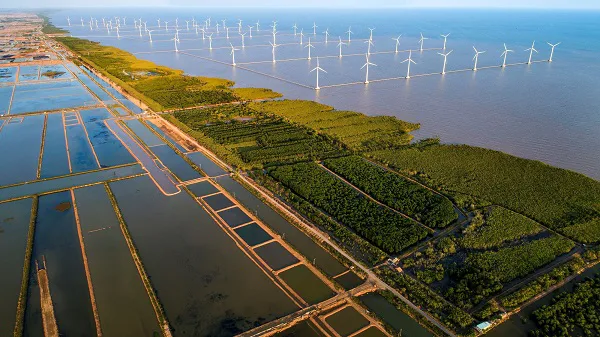Vietnam enhances transparency in emission reduction data management
Complying with the Paris Agreement requires Vietnam to institutionalize guidelines and tools for climate finance transparency.
Vietnam has kicked off a four-year project funded by the Global Environment Facility (GEF) to promote the implementation of regulations on greenhouse gas emissions to enhance transparency in emission reduction data management under the Paris Agreement.
| Pham Van Tan, Deputy Director of the Department of Climate Change under MONRE, and participants discuss the issues at the event held in Hanoi on Dec 1. Photo: UNDP |
The project entitled "Strengthen Vietnam's capacities to manage data flows and report information adequately to fulfill the enhanced transparency framework of the Paris Agreement requirements" (CBIT) aims to assist Vietnam in completing technical guidelines and providing professional training while monitoring financing resources for climate change response.
The CBIT project will strengthen the national system by focusing on capacity building and establishing procedures, guidelines, and tracking tools to comply with the Paris Agreement's obligations.
In support of the project which will be joined by different ministries and stakeholders, the United Nations Development Program (UNDP) said the CBIT project should continue updating the guidelines with systematic data collection for mitigation finance.
Institutionalizing these guidelines and tools for climate finance transparency is one of the key conditions for Vietnam to secure long-term and predictable climate finance for NDC implementation, particularly from international capitals, said Patrick Haverman, UNDP Deputy Resident Representative in Vietnam.
It is particularly important as Vietnam needs at least US$15-30 billion annually to implement NetZero 2050, he noted.
The Ministry of Natural Resources and Environment (MONRE) is the main factor in the project. Pham Van Tan, Deputy Director of the Department of Climate Change under MONRE, said this project has been formulated and implemented to address the aforesaid critical demands. He noted that the implementation of the Enhanced Transparency Framework of the Paris Agreement to Vietnam is quite new, requiring information on the relevant legal documents and related capacity-strengthening activities.
| A wind farm in Vietnam. Source: MONRE |
Over the years, as a party to the United Nations Framework Convention on Climate Change (UNFCCC) and the Kyoto Protocol, Vietnam has conducted greenhouse gas inventory activities, completed projects under the clean development mechanism (CDM), and taken steps to implement the transparency framework.
These restrictions were first codified in a Government Decree dated January 7, 2022, regarding reducing greenhouse gas emissions and protecting the ozone layer. Consequently, the National System of Measurement, Reporting and Evaluation of Mitigation of greenhouse gas (GHG) emissions is used to monitor and supervise compliance with the regulations on the mitigation of GHG emissions.
Recently, Vietnam became the third nation to join the Just Energy Transition Partnership with the G7+, following South Africa and Indonesia. It is anticipated that Vietnam will get $15.5 billion in support for the green transition program, which will speed up the execution of national commitments to reduce greenhouse gas emissions.
The outcomes of the CBIT Project will improve the precision, synchronization, and transparency in monitoring and reporting on the results of lowering greenhouse gas emissions in Vietnam, consequently enhancing the program's linkages and contributions.
Participating in the project implementation are MONRE, the Ministry of Planning and Investment, the Ministry of Industry and Trade, the Ministry of Transport, the Ministry of Construction, the Ministry of Agriculture and Rural Development, and relevant stakeholders.

.jpg)











